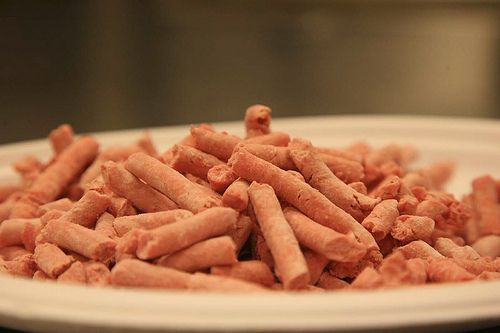‘Pink Slime’ Goes Back To School Lunches: 7 States Cut Costs With Introduction Of Lean, Finely Textured Beef

The controversial ammonia-washed, meat scrap product known to industry leaders as lean finely textured beef (LFTB) and critics as “pink slime” will return to school lunches in four more states for the coming school year, bringing the total number serving the product to seven.
Around this time last year, all but three states dropped out of the United States Department of Agriculture’s (USDA) option to receive beef that included LFTB: Iowa, Nebraska, and South Dakota. Many states opted out after British celebrity chef Jamie Oliver and a series of critical reports from ABC World News exposed over 70 percent of ground beef contained the controversial filler. Now, states are opting back in as the federal initiatives intended to subsidize school lunch cost haven’t met expectations, and LFTB-containing beef is poised to relieve that burden.
What Is Pink Slime? Is It Safe?
LFTB, or “pink slime,” is made from the fatty scraps of cattle carcasses, which get put into a centrifuge and subsequently washed in a bath of ammonium hydroxide to kill excess bacteria, such as Salmonella and E. coli. LFTB was once thought unfit for human consumption because of its high fat content.
The term “pink slime” was first coined by Gerald Zirnstein, a former microbiologist at the Food Safety Inspection Service, when he toured a Beef Products Inc. (BPI) factory in 2002 and saw the ammonia-bathing process, which turns the meat a pale shade of pink. Zirnstein e-mailed his colleagues afterward, saying he didn’t “consider the stuff to be ground beef,” the Washington Post reports.
"Basically, we're taking a product that would be sold in the cheapest way for dogs, and after this process, is being given to human beings," Oliver said on his show, Jamie Oliver's Food Revolution. "Why would any sensible human being put meat filled with ammonia in the mouths of their children?"
As it turns out, in Texas, Illinois, Pennsylvania, and Virginia, that is precisely what schools have reached out to the USDA for — though perhaps not as dramatically as Oliver asserts. As of Sept. 3, seven states put in orders to the USDA for about 2,000,000 lbs. of beef that could contain LFTB, Politico reports. The move could reduce costs by three percent across school lunch programs — a marginal decrease in the short term, but meaningful to the 31 million children who depend on school lunch programs.
“With the successful use of LFTB by [USDA’s National School Lunch Program] over the last 15 years, we are confident that these states and school districts will enjoy both quality and cost improvements,” said Craig Letch, director of food safety and quality assurance for BPI, the largest producer of LFTB. “This will ultimately enable them to provide more nutritious lean beef to their children.”
LFTB once saw mass incorporation in school lunch programs, before reports surfaced of ammonium hydroxide’s health risks and secrecy among beef manufacturers and fast-food restaurants. The USDA’s National School Lunch Program, for instance, has reduced its usage of LFTB by 95 percent in recent years. Some 7,000,000 lbs. of the beef product have been cut out of school lunches since the government purchased mass quantities of it last spring.
Ammonium hydroxide’s presence in food products isn’t a new development, and many health officials regard the chemical as a natural, safe addition. In 1974, the Food and Drug Administration (FDA) classified it as a Generally Recognized As Safe substance, meaning that "concentrations of ammonia and ammonium compounds normally present in food do not suggest a health risk; ammonia and ammonium ions are recognized to be integral components of normal metabolic processes."
Current FDA limits state ammonium hydroxide may not comprise more than 0.6-0.8 percent of the overall food product. Some typical consumer goods with ammonium hydroxide include puddings, cheeses, gelatins, and certain condiments. Cleaning products containing ammonium hydroxide typically sport concentration levels anywhere from 10 to 25 percent, depending on their intended use.
A Future Based On Choice
Based on the apparent stances of many school officials, the filler won’t make any massive returns anytime soon. Illinois’ largest school district, Chicago Public Schools, has adamantly abstained from reintroducing LFTB into the school-lunch program — specifically due to its clandestine reputation.
“They’ve taken the position that they’re not going to buy meat treated with ammonia and they’ve followed through on that,” Mark Bishop, vice president of policy for the Healthy Schools Campaign, told Politico. “This issue is really about labeling more than it is about nutrition. Whether in our homes or in our schools, we want to make informed choices. We want to know what’s in our food.”
In this, the issue of personal choice sits at the heart of the “pink slime” debate. The filler’s nutritional aspects are less well-known, and therefore less subject to parental oversight, than beef that doesn’t contain LFTB. It’s a form of doubt that leaves parents unsettled over the choice between caring for their child and providing an affordable lunch. Last year, a petition circulated around Change.org that sought to remedy the problem.
Bettina Siegel, a concerned mom from Houston, began the petition hoping the USDA would cease all purchasing of LFTB. Following nearly a quarter of a million signatures, the USDA announced that it would give schools the choice whether to buy LFTB, even though the USDA claims the filler is safe and nutritious.
“The vast majority of kids participating in the school lunch program are economically dependent on those meals,” Siegel said. “They have no choice but to eat what they’re served, and I believe we can do better by them than serving them beef with LFTB. That’s why I started my petition in the first place.”
Published by Medicaldaily.com



























